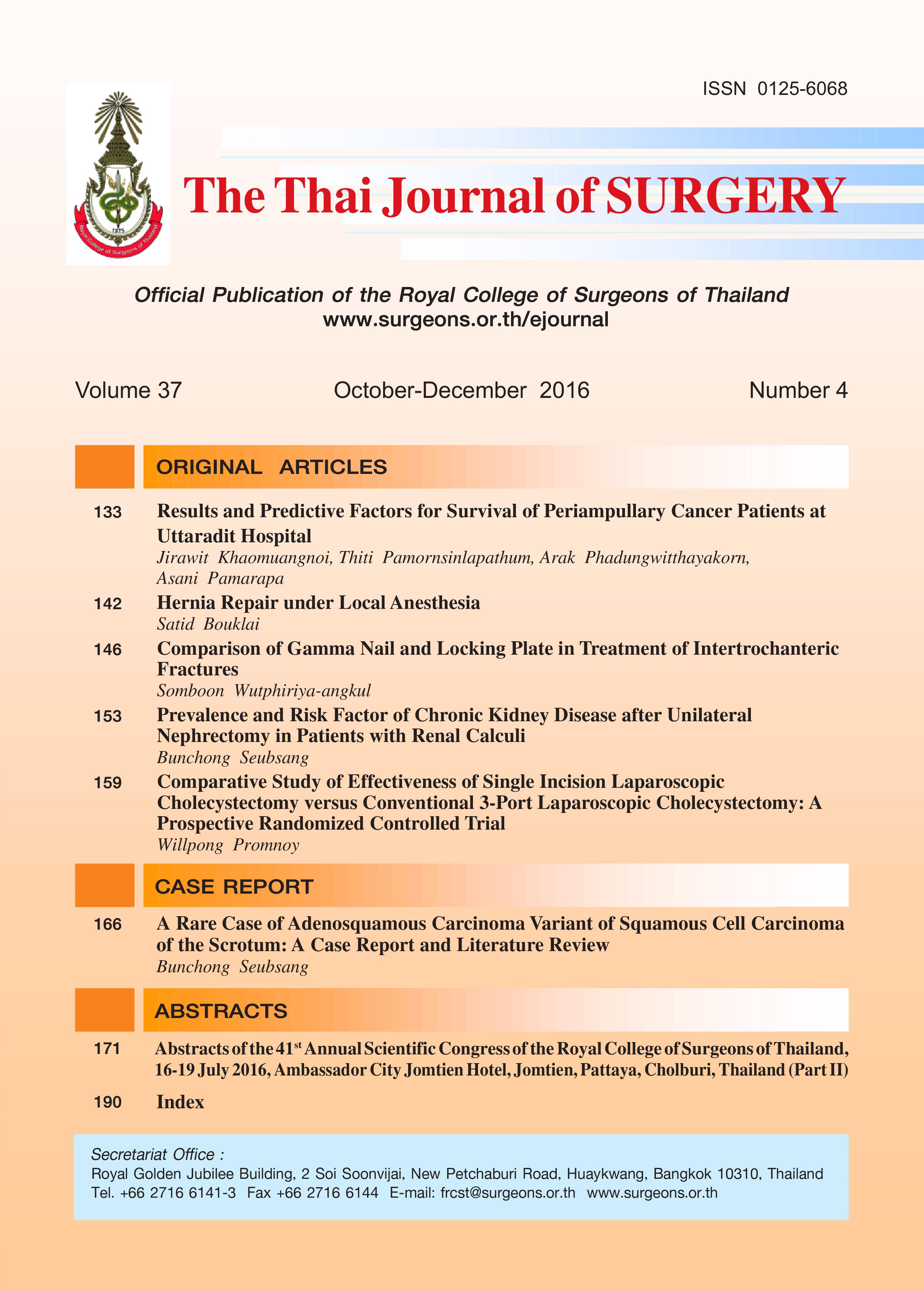Results and Predictive Factors for Survival of Periampullary Cancer Patients at Uttaradit Hospital
Keywords:
Periampullary cancer, Result, Predictive factor, SurvivalAbstract
Introduction: Periampullary cancer is one of the major health concerns worldwide. Even though there are some attempts to work the disease out, the prognosis of periampullary cancer remains poor.
Objective: To study results and predictive factors for survival of periampullary cancer patients at Uttaradit Hospital. Patients and Methods: A long-term observational analytic study was done. Information of 82 patients diagnosed with periampullary cancer who received treatment at Uttaradit Hospital from October 2007 to October 2012 was gathered from the database of Department of Surgery, Uttaradit Hospital. The patients’ final status had been followed until September 2015. Descriptive statistics, Kaplan-Meier method and a Log-rank test were applied to analyze the information.
Results: Patients had an average age of 64.99 years and 52.44% of them were male. All patients had primary tumors located in places as follows: 56.09% at the head of pancreas and 39.02% at the ampulla of Vater. Pancreaticoduodenectomy (PD) was performed in 48.78% of the patients. The overall mortality rate was 53.66%. The median survival time was 2.75 years. The predictive factors were chronic alcohol drinking (p < 0.01) and PD operation (p < 0.05).
Conclusion: Chronic alcohol drinking and a PD operation have significant contribution to the survival of periampullary cancer patients.
References
2. Jensen E, Borja-Cacho D. Exocrine pancreas . In: Townsend CM, Beauchamp RD, Evers BM, Mattox KL, editors. Sabiston Textbook of Surgery: The biological basis of modern surgicalpractice. 19th ed. Elsevier Saunders; 2012:1515-47.
3. NCCN Clinical Practice guidelines in Oncology. Pancreatic adenocarcinoma version 2. National comprehensivecancer network; 2015.
4. Hatzaras I, George N, et al. Predictors of survival in periampullary cancers following pancreaticoduodenectomy. Ann Surg Oncol 2010;17(4):991-97.
5. Chernrungroj G.Risk factors for cholangiocarcinoma: a casecontrol study. Doctor of philosophy in epidemiology. Yale University; 2000.
6. Honjo S, Srivatanakul P, Sriplung H, et al. Genetic and environmental determinants of risk for cholangiocarcinoma via Opisthorchis viverrini in a densely infested area in Nakhon Phanom, northeast Thailand. Intern J Cancer 2005;117:854-60.
7. Songserm N. Risk factors for cholangiocarcinoma in high risk area of Thailand: role of lifestyle, diet and polymorphisms in methylenetetrahydrofolate reductase. Doctor of philosophy in Public health. Khon Kaen University; 2011.
8. Edge S, Byrd D, Compton C, et al (eds). Cancer staging handbook form the AJCC Cancer Staging Manual. 7th ed. New York: Springer; 2010.
9. Jagannath P, Shrikhande S. Current options in the diagnosis and management of periampullary carcinoma. Ind J Surg 2003;65(4):347-53.
10. Fischer W, Anderson D. Pancreas. In: Brunicardi F, Anderson D, Billiar T, et al, editors. Schwartz’s Principle of surgery. 10th ed. Mc Graw Hill; 2015. p. 1341-422.
11. Diener MK, Heukaufer C, Schwarzer G, et al. Pancreaticoduodenectomy (classic Whipple) versus pylorus preserving pancreaticoduodenectomy (pp Whipple) for
surgical treatment of periampullary and pancreatic carcinoma. Cochrane Database systemic review 2011.
12. Yeo CJ, Sohn TA, Cameron JL, Hruban RH, Uiemoe KD, Pitt HA. Periampullary carcinoma Analysis of 5-Year Survivors. Ann Surg 1997;227(6):21-831.
13. Lim JE, Chien MW, Earle CC. Prognostic factors following curative resection for pancreatic adenocarcinoma: a population-based, linked database analysis of 396 patients.Ann Surg 2003;237:74-85.
14. Zerbi A, Balzano G. comparison between pylorus preserving and Whipple pancreatectomy. B J Surg 1995;82:975-79.
15. Neoptolemos JP, Dunn JA, Stocken DD, et al. Adjuvant chemoradiotherapy and chemotherapy in resectable pancreatic cancer: a randomized controlled trial. Lancet
2001;358:1576.
16. Roest MH, Gouw AS, Peeters PM, et al. Results of pancreaticoduodenectomy in patients with periampullary adenocarcinoma: perineural growth more important
prognostic factor than tumor localization. Ann Surg 2008; 248:97-103.
Downloads
Published
How to Cite
Issue
Section
License
Articles must be contributed solely to The Thai Journal of Surgery and when published become the property of the Royal College of Surgeons of Thailand. The Royal College of Surgeons of Thailand reserves copyright on all published materials and such materials may not be reproduced in any form without the written permission.



